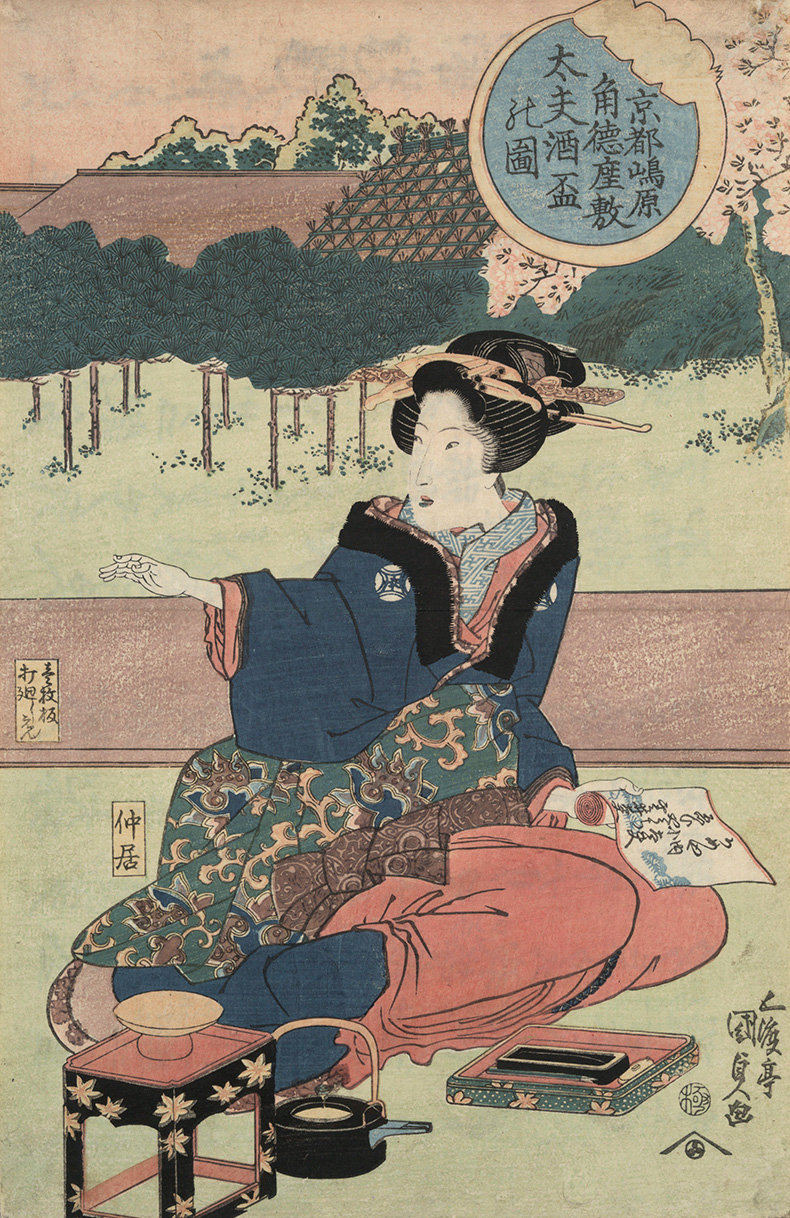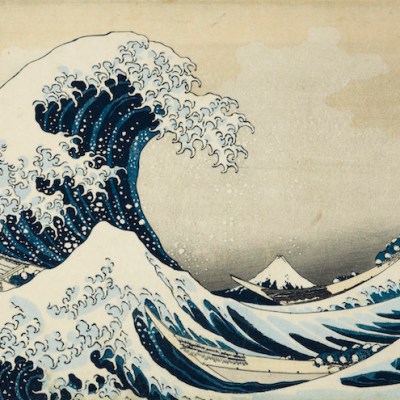From the February 2024 issue of Apollo. Preview and subscribe here.
When you think of Japanese printmakers, which names first spring to mind? Hiroshige and Hokusai, probably; perhaps not Utagawa Kunisada (1786–1865), whose work has started to gain more widespread recognition in only the last 50 years. Yet Kunisada was famous in his time – much more famous than Hiroshige, who was very keen to work with him, and comparable in renown to Hokusai, who was older.
Kunisada’s Courtesan at the Sumitoku Room in Kyoto Shimabara was made in the 1840s – towards the end of the Edo period, or Tokugawa shogunate. Change was in the air: the Sakoku Edict of 1635 had effectively closed Japan to foreigners, but the first Opium War between Britain and China (1839–42) sounded the bell of geopolitical instability in the Asia-Pacific region. British and Russian ships were bothering Japan’s ports, though it would be a few years before the American admiral Matthew Perry voyaged to Japan and, in the name of mercantilism, vigorously shook the country out of its isolationist mindset for good. All was not well at home: countless people were suffering from famine and fiscal turbulence, and in 1837 Oshio Heihachiro, though a member of the relatively well-off samurai class, had led an uprising that was quickly quashed. Samurai were gathering in Kyoto – the seat of the Japanese emperor – to put the world to rights.
They would often meet in the kind of pleasure house depicted in Kunisada’s woodblock. Shimabara was a red-light district, but unlike Kyoto’s Gion district, it catered to aristocrats and the higher echelons of Japanese society, and its women were expensive. Sumiya, the particular house depicted, was especially famous for the gathering of high-ranking people. It still exists today, as both a site of hospitality and a cultural museum.
This woodblock is a special one, likely created to commemorate a gathering of eminent people, as well as to commemorate Sumiya and its gardens – the detail of the background here, with the pine trees and profusion of roofs, suggests that this was a place of some significance. It seems an oasis amid violent sociopolitical flux.

Most of Kunisada’s known work depicts kabuki plays and players; he was also a noted creator of bijin-ga, or ‘beauty portraits’. Though not technically an example of bijin-ga – such artworks did not tend to include such elaborate backgrounds – Courtesan at the Sumitoku Room features three bijin, or ‘beauties’, sitting in the Sumitoku Room, a huge, open event space that could host up to a hundred people. The differentiation between the women is subtle. By today’s standards, they all look similar, their individuality to some extent effaced. Nonetheless, there’s plenty we can glean about these characters. Reading the triptych from right to left as intended, you first see, in the right-hand panel, the nakai (pictured above) – a sort of manager who would take care of any kind of business between the guests and the courtesans. It’s hard to make out the letters on the scroll of paper she’s holding, but it appears to bear two different names, presumably the names of the people who are coming to the event. She has made preparations to serve saké, which is significant – perhaps a marriage is afoot. Many women became courtesans because of family debts that had to be paid off, and when a courtesan got married – usually to one of her clients, who would have to have been extraordinarily wealthy – she would be freed from her bond.
But the special event about to take place is not necessarily of a nuptial nature: the scene looks relatively casual, there is only one saké cup instead of three, and the glamorous woman in the central panel is not wearing a white kimono. Whatever is taking place, it is clearly a major moment and special occasion for this poised young lady – a tayu, as labelled in the adjacent cartouche (pictured below). Tayu were the highest-ranking courtesans, having risen up from a previous role that may have involved sexual labour. They were also fashion icons, trained in a variety of arts including music, singing, dancing, poetry and calligraphy, and were expected to have enough worldly knowledge to be able to hold conversations with influential high-class clients. Such skills were mostly beyond the abilities of ordinary people, which meant that tayu enjoyed a high degree of social respect. (Tayu are not to be confused with geisha, who were artists and creative people with no professional sexual function.)

For a tayu like the one in the central panel, the ability to come to a grand pleasure house like this and share saké to seal an important transaction would have been a big deal – perhaps the high point of her career. This is conveyed by her outer robe, which features a design of a formidable dragon ascending from a choppy sea through what seems to be a whirlwind. The creature is a symbol of success: in Japanese folklore, a carp that manages to swim upstream through rapids and leap up a cascade becomes a dragon. This tayu, wearing this emblem in the prominent central panel, has evidently ‘made it’; she has arrived. The theme is reinforced by the imagery on her sash – an elaborate butterfly, implicitly transformed from a caterpillar. It’s even possible that this artwork was for the tayu, to commemorate this special occasion.
Like all woodblock prints, Courtesan at the Sumitoku Room would have been carefully conceived and executed. Kunisada would have drawn up the designs and the cartouches on paper, and suggested the colours; then the horishi, or woodblock carver, would have carved the obverse of the design into the wood, a mirror image of Kunisada’s conception. Then it would have gone to the printer, who would apply a given colour to the appropriate section of the woodblock and imprint that colour onto the single sheet. This last step would be repeated as many times as there were colours involved.
This print was likely made after the Tenpo reforms of the early 1840s, which promoted frugality and restricted the kinds of paints that could be used. Artists like Kunisada were limited to using only eight colours, when previously they had been able to use around 20. Paintings of courtesans were also banned as part of these reforms – perhaps this one slipped through the cracks.
The woman in the left panel, labelled in the cartouche by her arm as a hikifune, is not a courtesan but an assistant (pictured below); hikifune means ‘boat pulling [a big ship]’. She would take care of the tayu’s practical needs, such as handkerchiefs or water, while the nakai would check that the saké was prepared and that the ink was ready in case any documents needed signing – see the inkbrush and inkstone by her legs.
These women’s clothes are less eye-catching than the tayu’s, but intriguing details can be found in their sashes. The nakai’s ivy-like sash design is influenced by South East Asian patterns, particularly batik styles from Indonesia, which were highly prized in Japan. Meanwhile, the hikifune’s sash bears a flower design, probably the cherry blossom. Many plants came to Japan from China, but the cherry blossom was treasured by the Japanese as an indigenous tree. They have since been cultivated to withstand strong gusts, but the original mountainside cherry blossom trees were very delicate – they would fall in the face of the wind. This reflects a certain sentiment beloved of the Japanese, concerning things that are fragile and transient. The equation of life and death with cherry blossoms is often found in jisei, or Japanese death poems; even a unit of the kamikaze air force during the Second World War was named after the mountain cherry blossom.

Stepping back from the detail of the sashes, we can see that the triptych is strikingly composed. Many woodblock prints have a way of demarcating foreground from background, but in this particular piece the brown band running all the way through the centre of the triptych – representing flooring made of unusual, expensive wood, probably hinoki, or Japanese cypress – emphasises the prestige of the Sumitoku Room. The bright green of the floor in the foreground suggests fresh tatami, made of igusa grass reinforced with cotton and hemp threads. It may have been newly installed in the room, or perhaps Kunisada wanted to emphasise this occasion as a fresh start of some sort for the tayu. Certainly, it closely matches the green of the grass in the background, where the evergreen pines, often seen in woodblock works, hint at solidity, prestige and permanence – in fact, the pines you see in this print might still be standing today. They would already have been mature when Kunisada was designing this work – you can see the wooden posts holding up the branches of the pine, which grow so long that they droop without support. In the left panel, you can see two blue vases on a wooden table. These are probably a Shinto offering to the pine trees. They contain folded-up white paper, though we’ll never know what, if anything, was written on them.
What’s remarkable about this print is its detail, which really engages the eye and brings the scene to life. The tayu’s many turtle-shell kanzashi (hairpins), her outer robe – it’s impressive almost to the point of being excessive. The colour might have faded a little – the cinnabar orange of her sash with the blue butterflies would have been much more striking when the print was new. But the fresh green of the tatami, before it’s old and brown, comes across, as does the darker green of the pine leaves; and the blacks of the tayu’s dragon robe, the women’s hair, the stand for the cup in the right panel and the lacquer of the frame of the screen that bridges the right and central panels are as inky as ever.
That screen is a tsuitate, or a windscreen. It blocks the view of people, like those onlookers in the window in the left panel. (These figures are leaning out of a room that is labelled, in the sign below, as ‘aogai no ma’, or ‘blue shell room’ – probably a reference to the beautiful colour of the walls, further emphasising the splendour of this venue.) Of course, the tsuitate in this print isn’t exactly at the right angle to stop those people from looking at the tayu, but the function of such a screen in general is to give women privacy, space and some protection from the wind. The design on the tsuitate looks like the branches of a plum tree – the first tree whose buds open up in the winter. It symbolises strength and the early promise of good things.
So there are a lot of unusual elements in this print. The detail, the tayu, the location – it feels almost like an advertisement, showing off this location of the Sumitoko Room in Shimabara. But there is one intriguing, unintended element, hovering at the top of each of the panels: some dimly visible characters in Japanese script. In fact, they have nothing to do with this particular work. Each ukiyo-e is one sheet of paper, and in order to preserve it you’d use backing paper. Since paper was expensive – you wouldn’t have thrown it away casually; it was so valuable you could pay tax with it – you would reuse it once it had been written on and served its function. So what you’re seeing is the backing paper. What those letters say, however, is a mystery.
As told to Arjun Sajip by Sadako Ohki, associate curator of Japanese art at Yale University Art Gallery
From the February 2024 issue of Apollo. Preview and subscribe here.


